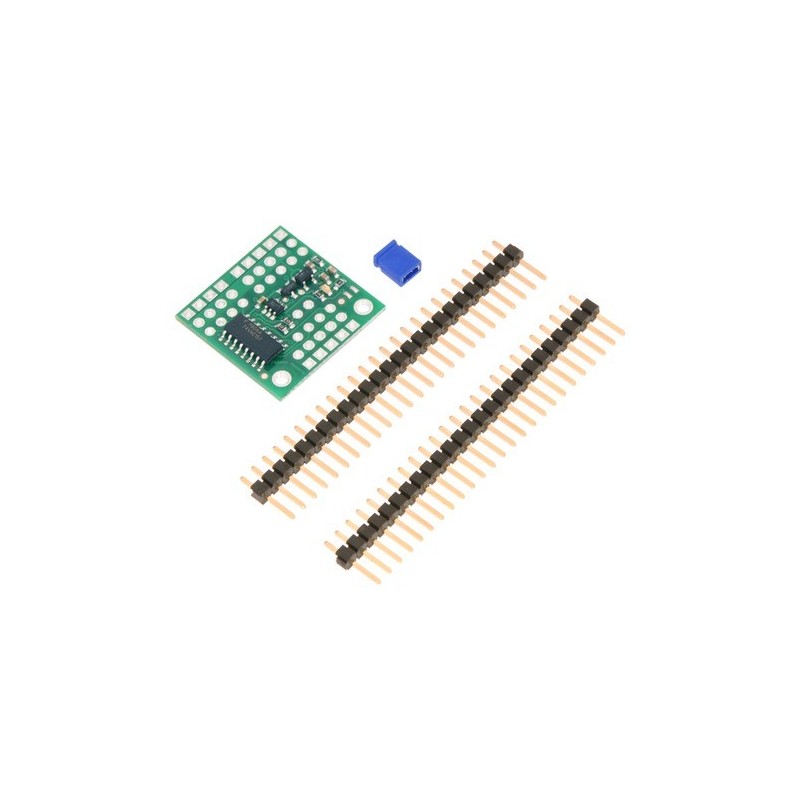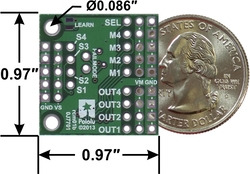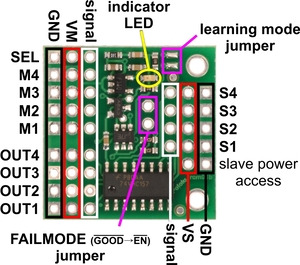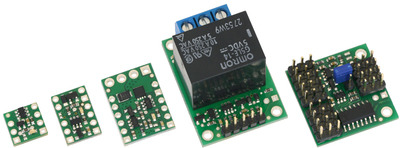

This compact four-channel multiplexer of hobby radio control pulses allows for easy switching between two independent signal sources. An auxiliary channel selects whether the output comes from the master or the slave source. The activation threshold and direction are configurable. Surface-mount components are pre-assembled on the PCB, but through-hole components are not installed and require soldering.
 |
The Pololu 4-Channel RC Servo Multiplexer can be used with standard hobby radio control systems and servo controllers to allow easy switching of servo control between two independent sources using a separate auxiliary channel as the input selector. This makes it ideal for applications in which you have two possible control sources and want to be able to switch between them on the fly. For example, you could connect two RC receivers to the same set of servos or electronic speed controls (ESCs) and allow the master transmitter to decide whether the master or slave transmitter is in control, thereby setting up your own buddy-system training setup. Another possible application would involve multiplexing between an RC receiver and a servo controller, which would allow you to switch between autonomous and manual control of a set of servos. The RC multiplexer is available preassembled with male header pins or as a partial kit that allows for greater application flexibility and more compact installations.
 |
The RC multiplexer measures the width of incoming RC pulses on the channel labeled SEL and compares it to a user-configurable threshold (with ą64 µs of hysteresis) to decide whether the master (M1–M4) or slave (S1–S4) inputs to the multiplexer should show up on the output channels (OUT1–OUT4). By default, the threshold is approximately 1700 µs and the slave inputs are only selected when the pulses on SEL are above this threshold. The multiplexer has a learning mode that allows you to change the threshold and activation direction. A yellow indicator LED provides feedback about the state of the RC multiplexer.
When the RC signal on the SEL channel is lost or invalid, the optional FAILMODE jumper determines the output behavior. If the jumper is left off, the master inputs will be in control. If the jumper is connected, the output channels go low and stay low for as long as the signal on the SEL channel remains invalid. For many servos and ESCs, a constant low on the signal line will turn them off, which might be desirable if the control signals are known to be bad.
The multiplexer considers the RC signal on the SEL channel to be valid if it has a 10–330 Hz pulse rate and 0.5–2.5 ms pulse width. The other inputs (S1–S4 and M1–M4) are unrestricted.
The power supplied by the master RC device should be between 2.5 and 16 V, and it must be capable of supplying the current that the servos connected to the outputs draw. The power pins of the SEL, M1–M4, and OUT1–OUT4 channels are all connected to the same VM rail, and the multiplexer draws its power from those pins. The power pins of the S1–S4 inputs are connected to each other on the VS rail but are not used by the board.
More information about using this product can be found in the user’s guide.
This product replaces items #721 and #722.
The Pololu 4-Channel RC Servo Multiplexer is available in two versions:
|
|
The RC multiplexer is essentially our Pololu RC Switch with digital output combined with a quad 2-input multiplexer. The LED behavior and configuration procedures are the same. However, the RC switches have a safe-start feature that is not enabled on the RC multiplexer. The RC switches have a GOOD output that is high when the signal is good, while the RC multiplexer has a GOOD output that is low when the signal is good (this signal can be accessed via the upper/octagonal pad of the FAILMODE jumper). The RC switches have an OUT output that indicates whether the switch is active; the RC multiplexer has the same signal, but it is not easily accessible.
 |
| The Pololu RC Switch family of products. |
|---|
Manufacturer BTC Korporacja sp. z o. o. Lwowska 5 05-120 Legionowo Poland sprzedaz@kamami.pl 22 767 36 20
Responsible person BTC Korporacja sp. z o. o. Lwowska 5 05-120 Legionowo Poland sprzedaz@kamami.pl 22 767 36 20
Servo control module. The operating parameters are configured by means of potentiometers placed on the board. SparkFun WIG-13118
No product available!
16-channel servo driver module with I2C interface based on the PCA9685 system. modPCA9685
No product available!
Servo driver with UART serial interface. Equipped with an ESP32 module with WiFi and Bluetooth wireless communication. Waveshare Servo Driver with ESP32
Universal tester of servos and ESC regulators. It allows you to check the operation of the servo without the need for a transmitter and receiver
Pololu Micro Maestro 1350 is a compact, versatile servo controller with a USB interface and autonomous operation capability, designed for use in robotics, animatronics, and control systems based on PCs or microcontrollers. Thanks to its flexible channel configuration, it can also be used as a sensor interface and I/O expander.
No product available!
A compact servo controller based on the PCA9685 chip, allowing simultaneous control of up to 16 RC servos. The board features a built-in Edge Connector for direct connection to the micro:bit and Link-compatible pads for easy integration with other modules. Power can be supplied via the terminal block or servo connectors, and a built-in switch and LED simplify operation. The controller provides a stabilized 3.3V output for the micro:bit and additional devices, making it a perfect central module in your project. Kitronik 5694
No product available!
Module with a 2-channel DC motor driver TB6612FNG designed to work with micro: bit. It can also control 3 servos. SB Components 14897
The motor driver card can drive 24 servo motors at most. It can be used to drive a multiple-joint robot machine, such as Hexapod Robot, Biped Robot, and Arm Robot. P0288
The servo driver module is an extension intended for minicomputers Raspberry Pi Zero / Zero W / Zero WH / 2B / 3B / 3B +. Allows you to control 16 PWM channels. Waveshare 15275
No product available!
Pololu Micro Maestro 1351 in kit version enables precise and flexible control of servos and sensors from a PC or microcontroller. Thanks to its ability to operate autonomously and function as a USB–TTL interface, it is used in motion control systems, animatronic projects, and interactive systems responding to external stimuli.
No product available!
Adafruit 16-Channel PWM / Servo HAT for Raspberry Pi - Mini Kit (Adafruit 2327)
An expansion board for the BBC micro:bit, allowing easy connection and control of low-power servos. It supports two servos by default, and up to three by disabling the built-in ZIP LEDs. Powered by three AAA batteries, it simultaneously supplies power to the micro:bit, while a power switch protects against unnecessary discharge. With five RGB ZIP LEDs and the ability to connect additional ones, the board allows for attractive lighting effects and is ideal for robotic projects like the :MOVE mini. Kitronik 5623
Advanced servo controller with UART and USB communication, enabling precise control of multiple servos simultaneously. Compact design and stable power supply via screw connector make the device ideal for integration in robots and automation systems with limited space. Cooperation with the Seeed Studio XIAO ecosystem and the use of serial bus instead of traditional PWM provide efficient, scalable and reliable control in educational, research and DIY projects. Seeed Studio 105990190
Universal tester of servos and ESC regulators. It allows you to check the operation of the servo without the need for a transmitter and receiver
Universal tester of servos and ESC regulators. It allows you to check the operation of the servo without the need for a transmitter and receiver

